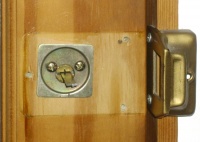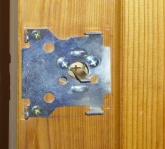Replace a lock cylinder
The technology of cylinder locks dates back thousands of years to the ancient Egyptians. Today's cylinder locks normally have a separate lock cylinder that can be replaced on its own.
The locks described here are known as night latches. They were popularised by Yale, so are often referred to as Yale locks. There are also other incompatible cylinder lock systems in use, such as eurolock.
How easy
The lock itself is not usually replaced, just the key cylinder, which is bought separately. It's a mostly simple job to fit a new rim lock cylinder. Misalignment on fitting can cause misbehaviour, but repositioning is trivial.
Why replace
Apart from the obvious...
A new rim lock cylinder is under £4-5 for a basic one, more with hardened pins in 2013. So replacement is sometimes cheaper than copying keys. New cylinders come with 2 or 3 keys.
When moving into a house, you've no idea who has keys. It's prudent to replace external cylinders.
Some house insurance policies are invalid if a cylinder without hardened pins is used on an external door.
The new cylinder
Lock cylinders (aka barrels) are standardised, so the main choices are brass or chrome finish, hardened or unhardened pins, and 5 or 6 pin.
- minimum cost cylinders are unhardened 5 pin, and can be drilled open.
- house insurance often requires hardened pins on external doors.
- hardened pin cylinders can be drilled, but it's more difficult, and can take a while, and several drill bits.
- unhardened is usually preferable for internal rooms & cupboards, easier to remove if keys are ever lost.
- You can also buy higher security cylinders from the likes of Abloy, Bramah, Ingersoll & Kaba, at a price. Not all are compatible with standard rim cylinder locks.
New lock cylinders come with 2 snapoff screws, a front mounting ring and a rear fixing plate in the pack. Don't try snapping these screws, they bend and are ruined.
It's not best practice to have new locks, cylinders or keys posted to you, the seller usually has your address, either from the delivery address or credit card details, and there are people that copy keys and misuse them.
Used cylinders are just as secure, if the seller doesn't know where you live. But unless they come with 3 keys they're often a false economy, as just one key copy costs as much as a new cylinder with keys.
How to replace
Once the lock is unscrewed, its not hard to see how it all goes together.
Gain access
If you're locked out and can't get in any other way, there are a few ways to gain access:
- Remove doorframe beading & push the lock tongue back with a knife
- Break a glass panel
- Standard lockpicking techniques
- Drill out the lock cylinder. Expect to ruin a few drill bits in the process. 4mm twist drills are good for the job, though if not careful more drill bits will be needed. Extra hard drill bits, such as cobalt, survive better.
Remove lock
Remove the visible screwheads fixing the lock, and lift it off.
There is also a separate backplate that holds the cylinder in place. These backplates come in 2 styles, the small type on the left, that holds the cylinder, or the larger type (right) that holds both cylinder and lock.
Remove old cylinder
As you'll see, the lock cylinder is held with 2 snapoff screws. Remove these, and the cylinder, the ring on the front, and often the plate on the rear all come away. Reuse these screws if they're not wrecked, its easier than cutting the new ones to length.
Refit backplate
If your lock uses a small backplate, skip this step.
If your lock uses a large backplate, and that's been removed for some reason, its best to screw the backplate back onto the door before the next step. Refit using the old screwholes (even if they're damaged). If the screws won't grip their holes, tap a matchstick into the offending hole, and snap off any match that sticks out.
Fit new cylinder
: : : : /|: :| |_|______ | | |---|) | | | | |============ | | | |________|---|) | | | \|: :| : : : : Ring, cylinder and backplate fitted to door (bird's eye view)
How it fits in is fairly obvious, ring at the front, plate at the back. Get the new cylinder in the right position, not rotated round out of place. There's usually a slight ring indentation in the door, sit the front ring in that to avoid a minor decorating mishap. Often the old front ring looks better than the new one, and on occasion the old rear plate is the only one that will sit flat enough.
Reuse the old cylinder fixing snapoff screws when possible, it avoids needing to cut the new ones. Occasionally, due to manufacturing imperfections, it can be necessary to swap the left & right screws over to get them to go in.
If the old screws can't be reused, the new ones can be chopped or sawn at the indentations. Don't try to snap them, a lot of these screws aren't hardened and just bend, ruining them instantly. If cutting screws, look at the cut end afterwards, and if any thread is distorted at the end, file the damaged bit of thread down.
The projecting tongue of the new cylinder needs to be cut to length. With cylinder fitted to door, mark on its tongue where it projects about halfway into the depth of the lock, and cut it off there. Length needn't be precise. A hacksaw works, but is slow and fiddly; bolt croppers or mini bolt croppers are very quick.
Refit lock
Refitting is just the reverse of removing it. The lock has a slot the cylinder's tongue goes into, then the lock is simply held in position and its fixing screws fitted.
Issues
Issues sometimes encountered:
Screw won't tighten
The lock screws won't tighten because the thread in the wood is stripped. Probably the simplest solution is to lightly hammer a matchstick into the hole in the wood door, and snap it off level. Or sometimes slightly fatter screws will fit and grip. Or if the screws are short, fit much longer ones.
Lock won't sit flat
Lock won't quite sit flat against the door. This happens when the rear plate that holds the lock cylinder fouls the lock. Loosen this backplate, reposition slightly and tighten, or if necessary remove it and put the old one back on instead.
Lock needs to accept old key
In some situations you might need a new lock that takes the old key. Rekeying a lock cylinder is a locksmith job. It's diyable in principle by changing pins, but few diyers would do it.
Stiffness
There are a few patterns of stiffness, with different causes. Oiling the cylinder is never the solution, and only causes staining of hands & clothing with dirty oil.
Stiffens up when turned
The new lock is too stiff to turn as far as is needed. If it turns in one direction ok, and opens the lock, no problem. If not, the cause is usually poor alignment between cylinder and lock. This tends to give huge variation in stiffness as the key is turned. Slacken the lock cylinder fixing and slide it sideways a tiny bit so it lines up better with the slot in the lock where the tongue goes, and retighten.
Consistently stiff to turn
If the amount of stiffness doesn't vary with key position, the fault is with the lock, not the cylinder. Open, clean and grease the lock mechanism. Lock parts do tend to spring out when opened.
Key needs waggling
If the key needs waggling to be able to turn, this is caused by a poorly cut key copy. It also happens on old lock cylinders that have had a lot of use, and the mechanism is well worn.
Key doesn't insert smoothly
The key needs waggling to insert, or is stiff to insert. Many keys have a series of raised points between the pin landing areas as a result of the way they're cut. This can cause keys to not go in smoothly. The solution is to file these raised points on the key down - obviously the pin landing areas must not be filed down.
In the picture to the right, the right key has these projections, the left one doesn't. The 5 flat low points between the projections in the right key are the pin landing areas.
Key doesn't turn
If a key just doesn't turn at all, it's not uncommon for a copied key to fail to work, due to a slight error in cutting. If the key is new, run the key in and out of the cylinder a few times before turning, this removes any residue left from key cutting.






